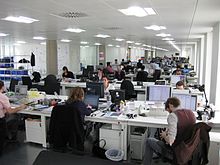Designation of workers by collar color
Collar color is a set of terms denoting groups of working individuals based on the colors of their collars worn at work. These can commonly reflect one's occupation within a broad class, or sometimes gender;[1] at least in the late 20th and 21st century, these are generally metaphorical and not a description of typical present apparel. For the two terms of longest use, white-collar workers are named for the white-collared shirts that were fashionable among office workers in the early and mid-20th century. Blue-collar workers are referred to as such because in the early 20th century, they usually wore sturdy, inexpensive clothing that did not show dirt easily, such as blue denim or cambric shirts.
Various other "collar" descriptions exist as well, although none have received the kind of broad use in American English as the traditional white-collar/blue-collar distinction.
White collar
[edit]
The term "white-collar worker" was coined in the 1930s by Upton Sinclair, an American writer who referenced the word in connection to clerical, administrative and managerial functions during the 1930s.[2] A white-collar worker is a salaried professional,[3] typically referring to general office workers and management.
Blue collar
[edit]
A blue-collar worker is a member of the working class who performs manual labor and either earns an hourly wage or is paid piece rate for the amount of work done. This term was first used in 1924.[4]
Pink collar
[edit]
A pink-collar worker is also a member of the working class who performs in the service industry. They work in positions such as waiters, retail clerks, salespersons, certain unlicensed assistive personnel, and many other positions involving relations with people. The term was coined in the late 1970s as a phrase to describe jobs that were typically held by women; now the meaning has changed to encompass all service jobs.[5][6][7]
Other classifications
[edit]There are a number of other terms used less frequently, or which translate to English from common use in other languages.[8]
- Red collar – Government workers of all types;[9][unreliable source?] derived from compensation received from red ink budget. In China, it also refers to Communist Party officials in private companies.[10]
- New collar – Develops technical and soft skills through nontraditional education paths.
- No collar – Artists and "free spirits" who tend to privilege passion and personal growth over financial gain. This term was popularized on the reality game show Survivor: Worlds Apart, which used No Collar (in addition to White and Blue Collar) as the tribal divisions;[11] also, people who work, but not for payment.[9]
- Orange collar – Prison laborers, named for the orange jumpsuits commonly worn by inmates.[9][unreliable source?][12]
- Green collar – Usually referring a wide range of professions relating to the environment and renewable energy, but can also refer to military personnel.
- Brown collar - Military personnel[citation needed]
- Scarlet collar – Workers in the sex industry[9][unreliable source?]
- Black collar – Manual laborers in industries in which workers generally become very dirty, such as mining or oil-drilling;[9][unreliable source?][13] has also been used to describe workers in illegal professions.[citation needed]
- Open collar – Refers to a worker who works from home, via Internet likely freelancers.[citation needed]
- Gold collar – Refers to young, low-wage workers who invest in conspicuous luxury. Alternatively refers to highly-skilled professionals in high-demand fields such as doctors, lawyers, engineers, pilots, actuaries and scientists.[14]
- Gray collar – Refers to labor which blurs the line between blue- and white-collar work. Gray collar work requires both physical and intellectual labour, and may require specialized training or college degrees. Commonly given examples of gray collar workers are first responders, electricians, nurses, technicians, conservationists, and pilots.[15][16]
References
[edit]- ^ Benczes, Réka (2006). Creative Compounding in English: The Semantics of Metaphorical and Metonymical Noun-Noun Combinations. Amsterdam: John Benjamins. pp. 144–146.
- ^ Oxford English Dictionary, 3rd edition. Electronically indexed online document. White collar, usage 1, first example.
- ^ "White-Collar". Cambridge Dictionary. 28 May 2022. Archived from the original on 3 May 2022. Retrieved 28 May 2023.
- ^ Wickman, Forrest. "Working Man's Blues: Why do we call manual laborers blue collar?" Slate.com, 1 May 2012.
- ^ Elkins, Kathleen (February 17, 2015) "20 jobs that are dominated by women" Business Insider
- ^ "Pink collar" Dictionary.com
- ^ Tennery, Ann (Mat 23, 2012) "The Term 'Pink Collar' Is Silly And Outdated — Let’s Retire It" Time
- ^ Van Horn, Carl; Schaffner, Herbert (2003). Work in America: M-Z. CA, USA: ABC-Clio Ltd. p. 597. ISBN 9781576076767.
- ^ a b c d e Biseria, Puneet (May 20, 2015) "Types of Collar" Archived 2018-04-22 at the Wayback Machine
- ^ "Red-Collars in Private Companies". Beijing Review. Jun 28, 2007. Retrieved 14 April 2015.
- ^ Feinberg, Daniel. "Recap: 'Survivor: Worlds Apart' Premiere – 'It's Survivor Warfare'". Hitfix. Hitfix, Inc. Retrieved 26 July 2015.
- ^ Pandeli, Jenna (2014). Orange-collar workers: an ethnographic study of modern prison labour and the involvement of private firms. Online Research @ Cardiff (PhD).
- ^ Friedrich, Thomas (2013) Hitler's Berlin: Abused City Spencer, Stewart (trans). New Haven, Connecticut: Yale University Press. ISBN 978-0-300-16670-5. p.12.
- ^ "Types of Collar Workers! (updated)". www.linkedin.com. Retrieved 2023-08-24.
- ^ "What Are Gray Collar Workers? | VensureHR". 2023-01-09. Retrieved 2024-10-02.
- ^ "Grey Collar Jobs". AIHR. Retrieved 2024-10-02.
